
Soil is the world's most vital component for food and fiber production, therefore, protection of such a key natural resource is of severe importance. The vast majority of farmers are greatly aware of the impact of sustainable land-use. As a result, an increasing demand for more information and better tools for monitoring the sustainability of their agricultural management arises.
Precision agriculture (PA) is an agricultural management concept based on monitoring and responding to inter and intra-field variability in crops. The desire to respond to production variability in both space and time using new emerging technologies on a fine-scale has become the goal of PA. Agricultural industry is in need of the capability to gather more comprehensive data on such variability and being able to accurately and timely respond to those changes. There are two main barriers to be overcome for its wider implementation:
- PA is 'information-intense'. Mapping of several soils, crops and environmental influences within a field generates 'data overload' for the farmer. Overcoming this issue requires the development of data integration tools, expert systems and decision support systems.
- There are several techniques for data acquisition for soil, crop and environmental factors but those methods are costly and labor intensive since most of them require soil sampling and laboratory analysis. Automatic sensor systems are needed for precision agriculture to be widely practiced.
Conventional soil testing techniques involve a sequence of steps (Benton Jones, 2001) from field sampling to laboratory analysis (wet chemistry) and ultimately the interpretation of those results as a decision providing tool. These steps are highly interdependent and each of them can affect the result obtained at another. Consequently, conclusions drawn for one aspect must necessarily take into consideration of all others.
Next page
Soil sampling is a very timely and labor intensive procedure. Furthermore, it is very sensitive and highly complex making it non-viable for non-experts to use. Timely procedures for soil analysis result in a slow response eliminating the opportunity farmers and soil scientists to ensure on-time responses. Other on-site techniques exist to measure the mechanical properties of soil such as standard penetration, cone penetration, dilatometers, pressure meters, vanes, flat and stepped blades, hydro-fracture, borehole shear and torsional probes.
All these methods are very expensive and are off-grid techniques. In the 21st century where technological advances allow for automated systems to provide remote operation and observation, a different approach is needed to provide real-time measurements of SQIs. In-situ soil condition monitoring with the use of chemical and physical sensors is an emerging research area with primary purpose to overcome the drawbacks of the past technologies. Specialized, less invasive underground sensors of low cost and wireless transmission is widely recognized as the best way forward.
Thick-Film technology demonstrates several advantages over the existing technologies. These include, flexibility of design and choice of materials, easy integration with electronic circuits, low cost in infrastructure and mass production, the possibility of automation of the fabrication process and a low barrier for technological transfer (from thick-film to other technologies, and vice versa).
Miniaturization is feasible, along with a high degree of electrochemical activity of the devices deriving from their high specific area and microporous structure. Currently, there are emerging technologies such as lab-on-a-chip (LOC), meaning a device that integrates one or more laboratory functions on a single substrate or board of only millimeters to a few square centimeters in size. LOC has become the focus of many researchers because it can provide fast, real-time data for many applications.
TF technology is compatible with LOC and can serve in the development and expansion of that area. Furthermore, TF technology can be integrated with other emerging technologies such as the Internet of Things (IoT) and all the information can be brought to the farmer, environmentalists and soil scientists in a timely manner and with much lower cost and labor.
Thick-Film (TF) Screen Printing initiated in ancient Chinese culture where silk cloth templates were used to deposit dye onto cloth in complex patterns. In the 1950s, it was proposed that, TF Technology could substitute the printed circuit board process. As the technology evolved, a whole new field of electronics, such as TF Hybrid circuits, appeared from the combined fabrication of components made by different technologies.
Next page
TF technology is defined as the successive sequential process of layer printing and firing in order to obtain the final conductor, insulator or resistive paths that are required for the specific application. Each layer is initially a paste that has a set of specific properties. Pastes' types can vary from conductors, resistors and dielectrics for crossovers, waterproofing or even capacitor pastes.
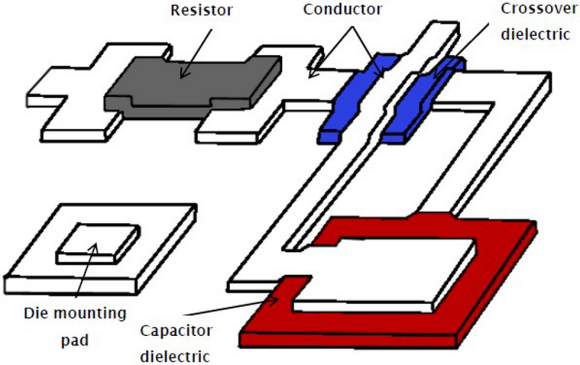
Fig. 1: Examples of Thick-Film Printing components. The components used for screen printing are shown and labelled on figure 2.
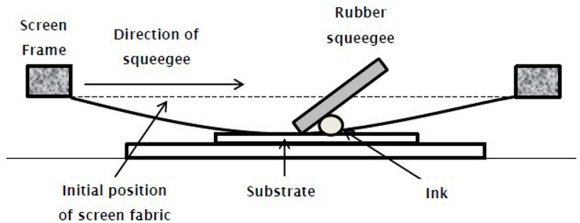
Fig. 2: Components of Thick-Film Screen Printing procedure.
Screen printing obeys a basic principle of operation. Ink is placed on the screen and the squeegee by moving from left to right or vice versa pushes the ink through the porous area of the screen and subsequently depositing the ink on the substrate at the desired position. Screens are made of highly tensioned stainless steel or polyester mesh, with a relatively open weave, to allow the printing paste to pass through it and have a transparency of about 40%.
Stainless steel has the best dimensional stability and a greater percentage open area than polyester, making it easier for the ink to go through the screen while polyester, is less likely to be damaged and is more easily deflected. High mesh counts can provide higher resolution but lower layer thickness.
Next page
Some basic rules for screen printing are:
- The particle size should be less than one third of the mesh opening size.
- The filament diameter should be less than one-third of the width of the narrowest line that will be printed.
- The frame size should be at least 1½–2 times the size of the image to be printed to allow the mesh to flex during printing without distorting the image significantly.
- The wet print thickness given by a piece of mesh is approximately equal to the thickness of the mesh multiplied by the percentage open area of the mesh.
After printing, the substrates with the printed layer must first be allowed to rest at room temperature for surface stress relaxation and then dried in a dryer for the solvent to evaporate. Then, the substrates are fired in a furnace, up to a temperature where the glass frit will melt and form a cohesive and adhesive film, carrying the conductor, resistor or dielectric materials. Temperatures and timing for drying and firing are defined by the ink manufacturers but for glassy inks the temperature range is about 400°C to 1,000°C. The suggested temperature profile is shown in figure 3.
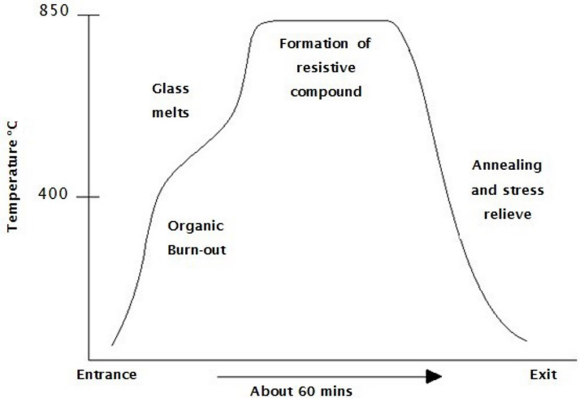
Fig. 3: Proper curing profile.
Nowadays, TF Technology has its main use in making chemical sensors and more often biosensors but also provides support structure to other sensors. TF adds to sensor development by using a film layer as the principal sensing element. TF sensors are often characterized in groups such as mechanical, chemical and magnetic. A huge number of TF sensors exist such as strain gauges, temperature sensors, pressure sensors, accelerometers, load cells, magneto-resistive sensors, thermopiles, chemical, physical and gas sensors.
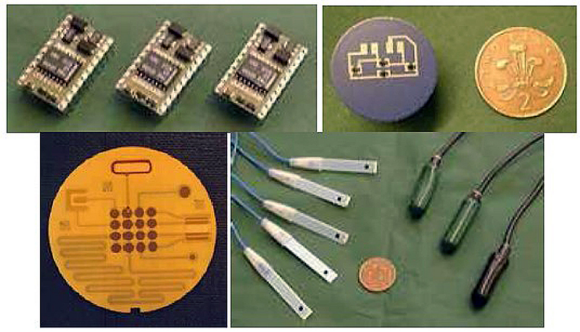
Fig. 4: Transmitters incorporating an operational amplifier (upper left), pressure sensor in a gearbox (upper right), water quality sensor (lower left), chemical sensors (lower right).
Next page
Several people at different universities around the world are focusing on TF sensor design for underground or water quality monitoring applications. Professor John Atkinson at the University of Southampton in the UK has developed a multi-sensor array for underground or water monitoring applications. The array size is approximately 25x50x1 mm and has conductivity, pH, dissolved oxygen and a temperature sensor (see figure 5). These sensors are all printed on an alumina substrate (aluminium oxide) and are all compatible with very simple electronics decreasing the cost even more.
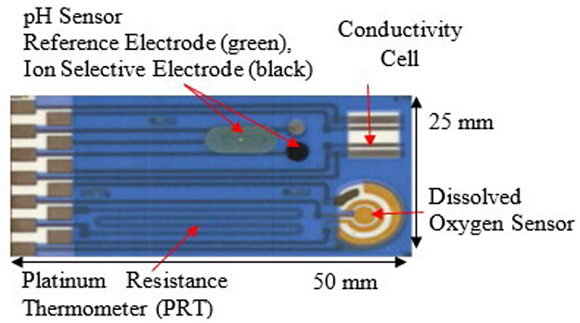
Fig. 5: Thick film multisensory array for subcutaneous deployments. It has conductivity, pH, temperature and oxygen sensors all incorporated on the same substrate.
Professor Eduardo Garcia-Breijo at the Polytechnic University of Valencia in Spain has developed an electronic tongue with 16 potentiometric electrodes made up of graphite, metal, metal oxides and insoluble metal salts. The array was able to monitor total biogenic amines, pH TVB-N and microbial analysis with correlations to laboratory equipment larger than 0.98.
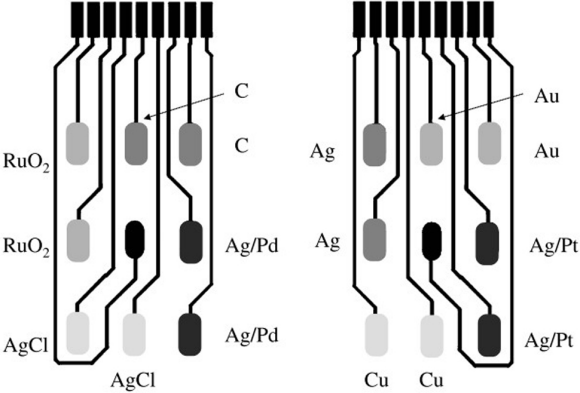
Fig. 6: Thick Film electronic tongue design containing an array of 16 electrodes.
Conclusion
These examples show that TF technology has the potential to be implemented in the solution of online real-time monitoring of soil and water parameters for a better control of soil and water quality, which has as a result the higher quality of food products reaching our homes every day. Although, the connection between sensing technologies and the Internet of Things is very obvious, it is very difficult to achieve as the size of data obtained from these sensing technologies is enormous and the transmission of such an amount of data is still an unsolved challenge.
About the Author
Marios Sophocleous obtained his PhD from the University of Southampton. He obtained his Master in Engineering as a Mechanical Engineer from the University of Southampton in 2011. He has already been a co-author of 7 scientific publications and co-author for four conference publications. He has also been the author for another conference paper in IEEE Sensors Conference 2012 in Taiwan and another one in IEEE Sensors Conference in Spain. His PhD project has as an aim to design low cost, miniaturized, thick-film underground chemical and physical sensors for soil and water quality monitoring. He is currently working as a Patent Analyst in Cyprus at IP Research Ltd and he is also the Founder and Director of Shrewd Instruments Ltd specialized in prototyping of application specific condition monitoring instruments.
Related Stories
Sustainable Farming and the IoT: Cocoa Research Station in Indonesia
Agrible Launches Find My Seed, a Seed Selector Tool for Growers
Industrial IoT Market Worth 151.01 Billion USD by 2020